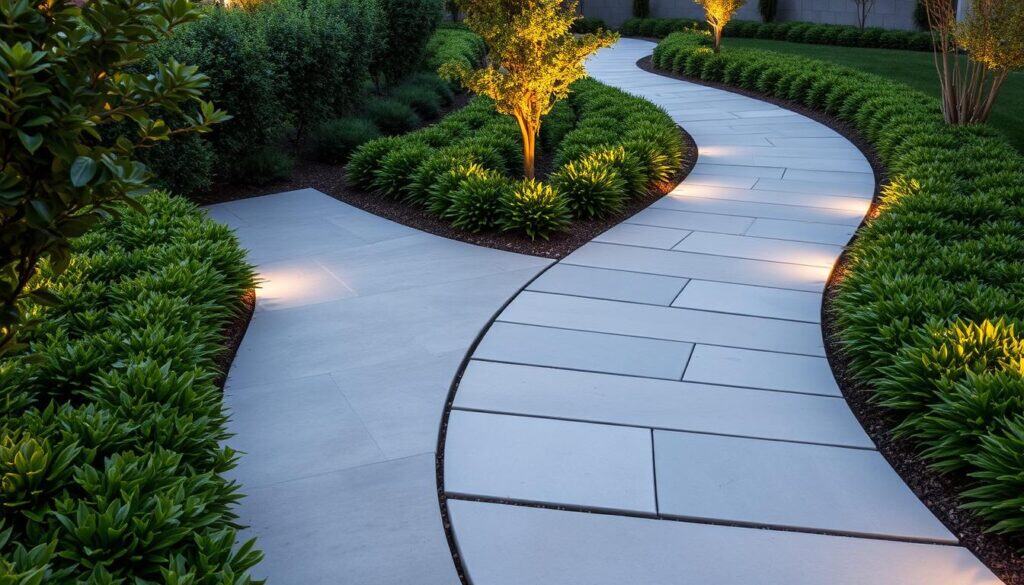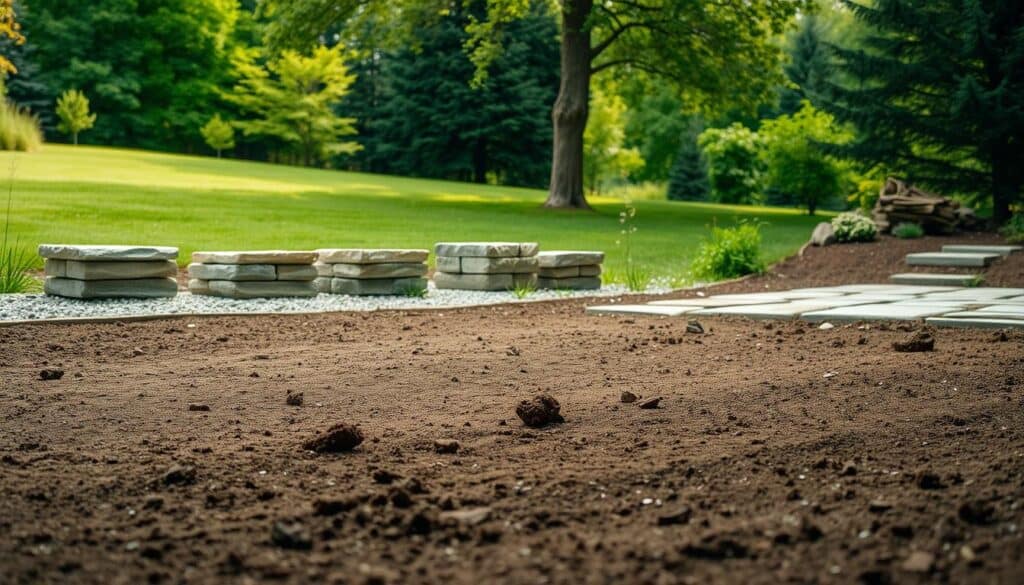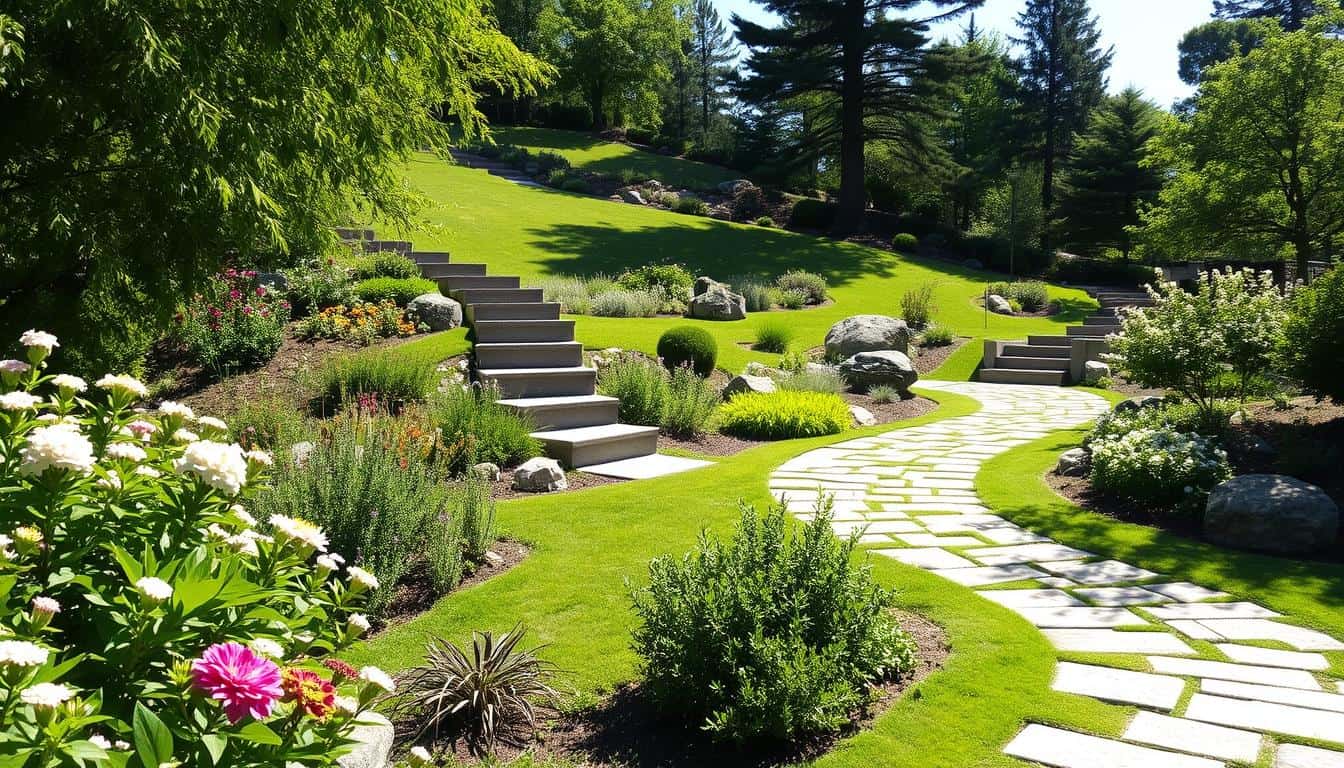Transforming your outdoor space into something both beautiful and practical doesn’t have to be complicated. Sometimes, all it takes is the right pathway to make your garden feel welcoming and complete. If you’re looking for inspiration, flagstone walkway ideas are a great place to start. With so many styles and patterns to choose from, you can create a path that not only guides friends and family through your garden but also adds a unique touch of personality and charm to your yard.
A flagstone walkway can be a stunning addition, offering a natural and rustic charm that complements various outdoor settings. Whether you’re looking to create a serene ambiance or a vibrant entertainment area, a thoughtfully designed walkway can elevate your landscape.
By incorporating outdoor pathways into your garden, you can create a harmonious balance between nature and functionality. This not only enhances the visual appeal of your property but also provides a safe and inviting route for exploration.
Key Takeaways
- Flagstone walkways can enhance the aesthetic appeal of your outdoor space.
- A well-designed pathway can guide visitors through your garden.
- Incorporating outdoor pathways creates a balance between nature and functionality.
- A thoughtfully designed walkway can elevate your landscape design.
- Outdoor pathways provide a safe and inviting route for exploration.
The Timeless Appeal of Flagstone Walkways
With their rich history and aesthetic versatility, flagstone walkways continue to captivate homeowners and landscapers alike. These walkways offer a unique blend of natural beauty and durability, making them a sought-after feature in landscape design.
Natural Beauty and Versatility
Flagstone walkways are renowned for their ability to complement various landscape styles, from rustic to modern designs. The natural variations in color and texture of the stone add depth and character to outdoor spaces.
- Enhance the aesthetic appeal of gardens and yards
- Offer durability and low maintenance
- Can be integrated with other landscaping elements
Historical Use in American Landscapes
The use of flagstone in American landscapes dates back to early colonial times, reflecting a long-standing appreciation for its beauty and practicality. Historically, flagstone walkways were used to create pathways that were both functional and visually appealing.
Today, they continue to be a popular choice, bringing a touch of timeless elegance to modern landscapes.
Types of Flagstone for Different Landscape Styles
Flagstone is a versatile material, available in several types, each with its unique characteristics and aesthetic appeal. This diversity allows homeowners and landscapers to choose the perfect flagstone that complements their landscape design.
Sandstone, Limestone, and Slate Options
Among the most popular types of flagstone are sandstone, limestone, and slate. Sandstone is known for its warm, earthy tones and texture, making it ideal for rustic and natural landscape designs. Limestone, with its classic, timeless appeal, is often used in more traditional and formal settings. Slate, characterized by its dark, rich colors, adds a sophisticated touch to modern landscapes.
Color Variations and Regional Availability
The color variations of flagstone are vast, ranging from neutral tones like beige and gray to deeper hues like red and black. The availability of these colors can vary significantly by region, depending on local quarries. For instance, certain regions in the United States are known for specific types of flagstone, making some colors more accessible than others.
Choosing the Right Thickness and Size
Selecting the appropriate thickness and size of flagstone is crucial for both aesthetic and functional reasons. Thicker stones are more durable and less prone to cracking, while thinner stones can be more cost-effective and easier to install. The size of the flagstone should be chosen based on the design pattern and the scale of the landscape.
Planning Your Flagstone Pathway Project
To ensure a successful flagstone pathway installation, start with a solid plan. A well-thought-out plan will help you achieve the desired look for your yard landscaping while avoiding potential pitfalls.
Mapping Your Walkway Layout
Begin by mapping out your walkway layout. Consider the path you want to create and how it will flow with the existing landscape. Think about the purpose of the pathway, whether it’s to lead to a front door, garden, or seating area. Use a hose or rope to visualize the path, and adjust as needed before finalizing your design.
Calculating Materials and Budget
Once you have your layout, calculate the materials needed. Measure the length and width of your pathway to determine how much flagstone you’ll need. Factor in the cost of other materials like sand, gravel, and edging. Create a budget that includes these costs, as well as any tools or professional services you might require. Budget planning is crucial to avoid unexpected expenses.
Preparing the Site Properly
Site preparation is critical for a stable and long-lasting flagstone pathway. Clear the area of debris, vegetation, and obstructions. Check for utilities and mark their locations. Level the ground, and lay down a base material like compacted gravel to ensure proper drainage. A well-prepared site will make the installation process smoother and more efficient.
- Carefully plan your flagstone pathway project.
- Map out your walkway layout.
- Calculate materials and create a budget.
- Prepare the site properly.
10 Stunning Flagstone Walkway Ideas for Front Yards
Creating a lasting impression starts with the right pathway, and flagstone walkways are an excellent choice for enhancing your home’s curb appeal.
Flagstone walkways are not just functional; they add a touch of elegance and sophistication to your front yard. Here are some stunning ideas to inspire your next landscaping project.
Formal Entryway Designs
A formal entryway sets the tone for your home’s exterior. Using flagstone for your walkway can create a grand entrance that is both inviting and majestic. Consider pairing flagstone with complementary materials like brick or concrete for a cohesive look.
Formal flagstone walkways can be designed with straight lines or subtle curves, depending on your home’s architectural style.
Curved Approaches to Enhance Curb Appeal
Curved flagstone walkways can add a soft, welcoming touch to your front yard. This design approach can guide visitors naturally to your front door while creating a visually appealing pathway.
Combining Flagstone with Decorative Borders
Incorporating decorative borders with your flagstone walkway can elevate its visual appeal. Options include using gravel, brick, or even plants to create a unique and personalized look.
| Design Element | Description | Benefits |
|---|---|---|
| Flagstone | Natural stone used for the walkway | Durable, versatile, and aesthetically pleasing |
| Decorative Borders | Materials like gravel, brick, or plants | Adds visual interest and can enhance curb appeal |
| Curved Design | Soft, curved pathway | Creates a welcoming atmosphere and guides visitors to the front door |
By incorporating these flagstone walkway ideas into your landscaping project, you can significantly enhance your home’s curb appeal and create a beautiful, functional front yard.
Natural and Rustic Flagstone Walkway Ideas
For homeowners seeking a more organic landscape design, natural and rustic flagstone walkways offer a serene and inviting pathway solution. These walkways not only enhance the aesthetic appeal of your garden but also create a harmonious connection with nature.
Woodland Path Designs with Irregular Stones
Creating a woodland path with irregular flagstones can transport you to a secluded forest glade. The irregular shapes and sizes of the stones mimic the natural patterns found in the wilderness, making your garden feel like an extension of the surrounding landscape.
Key Features: Use a mix of large and small stones, vary the stone shapes, and incorporate native plants along the pathway.
Moss and Thyme-Filled Joints
Filling the joints between flagstones with moss or thyme not only adds to the natural beauty but also creates a soft, lush carpet underfoot. This approach is particularly effective in shaded areas where moss thrives.
Tip: Choose low-growing, spreading plants like thyme or creeping Jenny to fill the joints, ensuring they don’t overshadow the flagstones.
Dry Creek Bed Combinations
Combining flagstone walkways with dry creek beds is a clever way to manage water runoff while adding visual interest to your garden. The contrast between the solid flagstones and the loose creek bed materials creates a dynamic landscape feature.
| Design Element | Description | Benefits |
|---|---|---|
| Irregular Flagstones | Varied shapes and sizes | Creates a natural, organic look |
| Moss-Filled Joints | Soft, lush carpet | Low maintenance, aesthetic appeal |
| Dry Creek Beds | Manages water runoff | Reduces erosion, adds visual interest |
By incorporating these natural and rustic elements, you can create a flagstone walkway that not only complements your garden’s natural beauty but also enhances its overall appeal.
Modern Flagstone Pathway Designs
Modern flagstone pathways are redefining outdoor spaces with their sleek designs and natural beauty. These pathways are perfect for homeowners looking to add a touch of elegance to their landscapes.

The use of geometric patterns and clean lines in flagstone pathway designs is becoming increasingly popular. This approach creates a visually appealing and modern look that complements contemporary homes.
Geometric Patterns and Clean Lines
Geometric patterns can be achieved by arranging flagstone in specific designs, such as herringbone or running bond. These patterns add visual interest to the pathway and create a sense of sophistication.
Minimalist Approaches for Contemporary Homes
For contemporary homes, a minimalist approach to flagstone pathway design can be particularly effective. This involves using simple, clean lines and a limited color palette to create a sleek and modern look.
Floating Slab Designs
Floating slab designs are another popular trend in modern flagstone pathways. This design involves placing flagstone slabs in a way that creates a sense of floating on the ground, adding a touch of drama to the landscape.
By incorporating these modern design elements, homeowners can create a beautiful and functional flagstone pathway that enhances their outdoor space.
Regional Flagstone Walkway Ideas Across America
From the desert landscapes of the Southwest to the lush forests of the Pacific Northwest, regional characteristics play a significant role in shaping flagstone walkway ideas. This diversity in landscape and climate across America offers homeowners a wide range of design inspirations for their outdoor spaces.
Desert Southwest Inspirations
In the Desert Southwest, flagstone walkways often blend seamlessly with the natural surroundings. The use of earth-toned flagstones complements the desert flora and arid landscape. Designs often incorporate drought-resistant plants and gravel or sand-filled joints to reduce water consumption and maintenance.
New England Traditional Designs
New England’s traditional landscapes often feature flagstone walkways that echo the region’s historic charm. Classic designs might include flagstone laid in a random pattern, complemented by lush greenery and traditional New England foliage. The cool, muted colors of the flagstone often match the region’s stone walls and buildings.
Pacific Northwest Rain-Friendly Pathways
The Pacific Northwest is known for its rainfall, making drainage a key consideration for flagstone walkways in this region. Rain-friendly pathways often feature permeable designs, with wide joints filled with gravel or sand to facilitate water drainage. This not only helps to manage rainwater but also adds to the natural, moss-covered aesthetic that is characteristic of the region.
Combining Flagstone with Other Materials
Enhance your outdoor space by combining flagstone with gravel, brick, or wood. This approach allows for the creation of unique and visually appealing pathways that can significantly elevate your landscape design.
One effective way to combine flagstone is by using it with gravel. The contrast between the solid flagstone and the loose gravel creates a visually interesting pathway. Flagstone and gravel combinations are particularly effective in rustic or natural landscape designs.
Gravel Combinations
When pairing flagstone with gravel, consider the color and texture of both materials. The gravel can be used to fill gaps between flagstone slabs, creating a stable and attractive surface. This combination works well in woodland or naturalistic garden settings.
Integrating Brick and Concrete Elements
For a more formal or traditional look, flagstone can be combined with brick or concrete. This blend of materials can create a striking contrast that adds visual interest to your pathway. Brick and concrete elements can be used to create borders or patterns within the flagstone.
Wood and Flagstone Hybrid Pathways
Another innovative approach is to combine flagstone with wood, creating a hybrid pathway that blends the natural warmth of wood with the durability of flagstone. This combination is particularly effective in modern or contemporary landscape designs.
By thoughtfully combining flagstone with other materials, you can create a pathway that not only complements your landscape but also adds a unique touch to your outdoor space.
DIY Installation Guide for Flagstone Walkways
With the right tools and a bit of patience, you can install a stunning flagstone walkway yourself. This comprehensive guide will walk you through the essential steps and considerations for a successful DIY flagstone installation.
Essential Tools and Materials
Before starting your project, gather the necessary tools and materials. You’ll need flagstone slabs, sand or gravel base material, a shovel, a level, a tamping tool, and a wheelbarrow. Choosing the right materials is crucial for the durability and appearance of your walkway.
- Flagstone slabs
- Sand or gravel for the base
- Weed barrier fabric (optional)
- Edge restraints
Step-by-Step Installation Process
The installation process involves several key steps. First, prepare the site by clearing the area and marking the walkway path. Then, excavate the area to the required depth and lay down a base material.
- Clear and mark the walkway area
- Excavate to the appropriate depth
- Lay down the base material and compact it
- Begin laying flagstone slabs, leaving appropriate gaps for sand or gravel
Mortared vs. Dry-Laid Methods
You can install flagstone using either mortared or dry-laid methods. Dry-laid installations are more forgiving and allow for better drainage, while mortared installations provide a more stable and permanent surface.
Proper Base Preparation Techniques
A well-prepared base is essential for a stable and long-lasting flagstone walkway. Ensure the base is compacted and level to prevent settling or shifting over time.

When setting flagstone slabs, use a level to ensure they are even and adjust as necessary. Fill the gaps between stones with sand or gravel to stabilize the slabs and prevent weed growth.
Enhancing Your Flagstone Walkway with Landscaping
To create a truly captivating outdoor environment, consider enhancing your flagstone walkway with thoughtful landscaping choices. A well-designed walkway is not just a path; it’s an invitation to explore your garden or yard.
Complementary Plant Selection
Choosing the right plants to surround your flagstone walkway can significantly enhance its beauty. Consider plants that complement the color and texture of your flagstone. For instance, if you have a sandstone flagstone, plants with soft, delicate foliage like thyme or moss can create a harmonious look.
- Ornamental grasses
- Creeping juniper
- Daylilies
- Ferns
Lighting Options for Safety and Ambiance
Proper lighting can transform your flagstone walkway into a magical pathway in the evening. Solar-powered lights are an eco-friendly option that can be placed along the edges of your walkway. For a more dramatic effect, consider using low-voltage LED lights that can be embedded among the stones or along the pathway’s border.
Water Features Along Pathways
Incorporating water features near your flagstone walkway can add a soothing element to your landscape. A small fountain or a bubbling rock feature can create a calming ambiance. When designing a water feature, consider the scale and style of your walkway and surrounding landscape to ensure a cohesive look.
By incorporating these landscaping elements, you can turn your flagstone walkway into a stunning focal point of your outdoor space.
Maintaining and Preserving Your Flagstone Investment
To ensure your flagstone walkway remains a beautiful and functional part of your landscape, regular maintenance is crucial. Proper care not only enhances the aesthetic appeal but also extends the lifespan of your flagstone investment.
Seasonal Care Requirements
Different seasons bring unique challenges to your flagstone walkway. In the spring, inspect your walkway for damage caused by winter weather. Summer months require regular cleaning to remove dirt and debris. During fall, clear leaves and prepare your walkway for winter by sealing it if necessary. In winter, avoid using harsh chemicals to melt ice, as they can damage the stone.
Cleaning and Sealing Best Practices
Cleaning your flagstone walkway regularly is essential to maintain its appearance. Use a mild detergent and water to clean the surface. For more stubborn stains, a mixture of baking soda and water can be effective. Sealing your flagstone periodically helps protect it from the elements and enhances its color.
Repairing and Replacing Damaged Stones
Over time, flagstone can become damaged or worn. Repairing or replacing damaged stones is crucial to maintaining the integrity and appearance of your walkway. For minor repairs, re-grouting or re-sanding may be sufficient. For more significant damage, replacing individual stones may be necessary.
| Maintenance Task | Frequency | Benefits |
|---|---|---|
| Cleaning | Regularly | Maintains appearance, prevents staining |
| Sealing | Periodically (every 2-5 years) | Protects from elements, enhances color |
| Inspecting | Seasonally | Identifies damage early, prevents further deterioration |
Conclusion: Transforming Your Landscape with Flagstone Walkways
Flagstone walkways offer a unique opportunity to transform your outdoor landscape into a beautiful and functional space. By incorporating flagstone into your landscape design, you can create stunning outdoor pathways that enhance your home’s curb appeal and provide a safe and inviting route for visitors.
Throughout this article, we’ve explored various flagstone walkway ideas, from formal entryway designs to natural and rustic pathways. We’ve also discussed the importance of planning, installation, and maintenance to ensure your flagstone walkway remains a beautiful and durable feature of your landscape.
By applying the ideas and advice presented, you can create a flagstone walkway that not only complements your home’s architecture but also reflects your personal style. Whether you’re looking to enhance your landscape design or simply create a more inviting outdoor space, flagstone walkways are an excellent choice for transforming your landscape.



